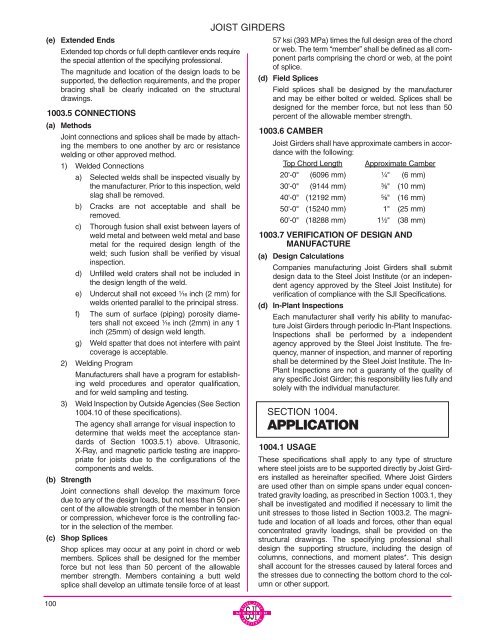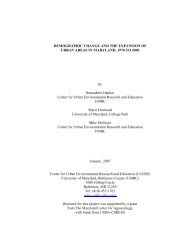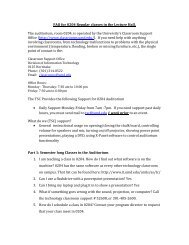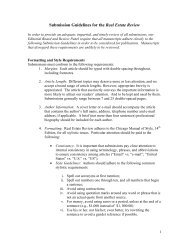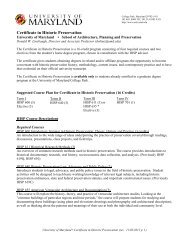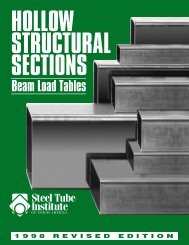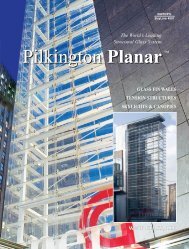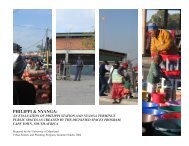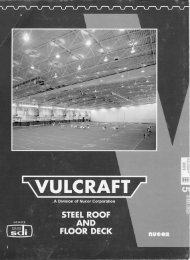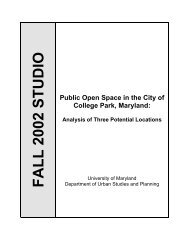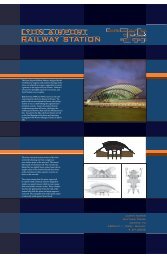Vulcraft_Joist_Catal..
Vulcraft_Joist_Catal..
Vulcraft_Joist_Catal..
- No tags were found...
Create successful ePaper yourself
Turn your PDF publications into a flip-book with our unique Google optimized e-Paper software.
(e) Extended Ends<br />
Extended top chords or full depth cantilever ends require<br />
the special attention of the specifying professional.<br />
The magnitude and location of the design loads to be<br />
supported, the deflection requirements, and the proper<br />
bracing shall be clearly indicated on the structural<br />
drawings.<br />
1003.5 CONNECTIONS<br />
(a) Methods<br />
Joint connections and splices shall be made by attaching<br />
the members to one another by arc or resistance<br />
welding or other approved method.<br />
1) Welded Connections<br />
a) Selected welds shall be inspected visually by<br />
the manufacturer. Prior to this inspection, weld<br />
slag shall be removed.<br />
b) Cracks are not acceptable and shall be<br />
removed.<br />
c) Thorough fusion shall exist between layers of<br />
weld metal and between weld metal and base<br />
metal for the required design length of the<br />
weld; such fusion shall be verified by visual<br />
inspection.<br />
d) Unfilled weld craters shall not be included in<br />
the design length of the weld.<br />
e) Undercut shall not exceed ¹⁄₁₆ inch (2 mm) for<br />
welds oriented parallel to the principal stress.<br />
f) The sum of surface (piping) porosity diameters<br />
shall not exceed ¹⁄₁₆ inch (2mm) in any 1<br />
inch (25mm) of design weld length.<br />
g) Weld spatter that does not interfere with paint<br />
coverage is acceptable.<br />
2) Welding Program<br />
Manufacturers shall have a program for establishing<br />
weld procedures and operator qualification,<br />
and for weld sampling and testing.<br />
3) Weld Inspection by Outside Agencies (See Section<br />
1004.10 of these specifications).<br />
The agency shall arrange for visual inspection to<br />
determine that welds meet the acceptance standards<br />
of Section 1003.5.1) above. Ultrasonic,<br />
X-Ray, and magnetic particle testing are inappropriate<br />
for joists due to the configurations of the<br />
components and welds.<br />
(b) Strength<br />
Joint connections shall develop the maximum force<br />
due to any of the design loads, but not less than 50 percent<br />
of the allowable strength of the member in tension<br />
or compression, whichever force is the controlling factor<br />
in the selection of the member.<br />
(c) Shop Splices<br />
Shop splices may occur at any point in chord or web<br />
members. Splices shall be designed for the member<br />
force but not less than 50 percent of the allowable<br />
member strength. Members containing a butt weld<br />
splice shall develop an ultimate tensile force of at least<br />
100<br />
JOIST GIRDERS<br />
57 ksi (393 MPa) times the full design area of the chord<br />
or web. The term “member” shall be defined as all component<br />
parts comprising the chord or web, at the point<br />
of splice.<br />
(d) Field Splices<br />
Field splices shall be designed by the manufacturer<br />
and may be either bolted or welded. Splices shall be<br />
designed for the member force, but not less than 50<br />
percent of the allowable member strength.<br />
1003.6 CAMBER<br />
<strong>Joist</strong> Girders shall have approximate cambers in accordance<br />
with the following:<br />
Top Chord Length Approximate Camber<br />
20'-0" (6096 mm) ¹⁄₄" (6 mm)<br />
30'-0" (9144 mm) ³⁄₈" (10 mm)<br />
40'-0" (12192 mm) ⁵⁄₈" (16 mm)<br />
50'-0" (15240 mm) 1" (25 mm)<br />
60'-0" (18288 mm) 1¹⁄₂" (38 mm)<br />
1003.7 VERIFICATION OF DESIGN AND<br />
MANUFACTURE<br />
(a) Design Calculations<br />
Companies manufacturing <strong>Joist</strong> Girders shall submit<br />
design data to the Steel <strong>Joist</strong> Institute (or an independent<br />
agency approved by the Steel <strong>Joist</strong> Institute) for<br />
verification of compliance with the SJI Specifications.<br />
(d) In-Plant Inspections<br />
Each manufacturer shall verify his ability to manufacture<br />
<strong>Joist</strong> Girders through periodic In-Plant Inspections.<br />
Inspections shall be performed by a independent<br />
agency approved by the Steel <strong>Joist</strong> Institute. The frequency,<br />
manner of inspection, and manner of reporting<br />
shall be determined by the Steel <strong>Joist</strong> Institute. The In-<br />
Plant Inspections are not a guaranty of the quality of<br />
any specific <strong>Joist</strong> Girder; this responsibility lies fully and<br />
solely with the individual manufacturer.<br />
SECTION 1004.<br />
APPLICATION<br />
1004.1 USAGE<br />
These specifications shall apply to any type of structure<br />
where steel joists are to be supported directly by <strong>Joist</strong> Girders<br />
installed as hereinafter specified. Where <strong>Joist</strong> Girders<br />
are used other than on simple spans under equal concentrated<br />
gravity loading, as prescribed in Section 1003.1, they<br />
shall be investigated and modified if necessary to limit the<br />
unit stresses to those listed in Section 1003.2. The magnitude<br />
and location of all loads and forces, other than equal<br />
concentrated gravity loadings, shall be provided on the<br />
structural drawings. The specifying professional shall<br />
design the supporting structure, including the design of<br />
columns, connections, and moment plates*. This design<br />
shall account for the stresses caused by lateral forces and<br />
the stresses due to connecting the bottom chord to the column<br />
or other support.


